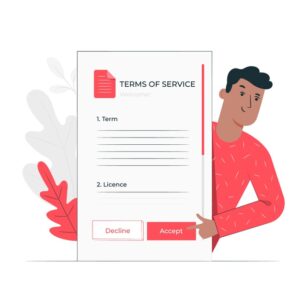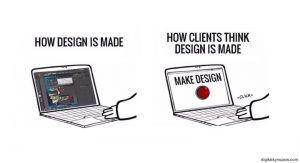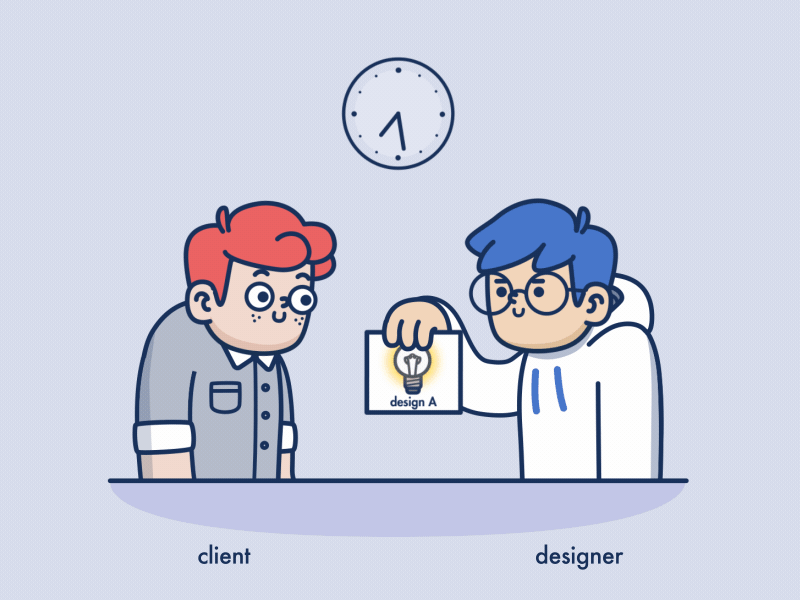How to manage your clients’ emendation requests expertly?
Spending multiple hours on a design and submitting it to the client is an exciting task when the outcome is sheer praise. But the designs are not always satisfactorily accepted by the clients. There comes a need to manage your clients. Most of the time, an email pops up from your client with a tag “the design is not up to the mark/I am not okay with the received design/you need to make suitable changes to your design” etc. Yes! It is super frustrating…
Even if the client is looking for a minor correction in the design, you have to pass through a grinding phase of revising the entire draft. Clients are always girded by confusion regarding their design requirements. They get a little bit idea about their needs once they see your primary draft. This means getting piles of revision requests from the clients. They are unaware of the fact that graphic designing is not a piece of cake rather it requires great effort on your part.
As you are not free enough to give graphic design tutorials to your clients so it’s better to wear the cloak of customer service and get to your design emendation tasks. To keep both sides cheery, you should take notice of some tips for managing the correction requests aptly.
Set sharp boundaries:
To work with the aim of pleasing your clients is a secondary concern. The primary element should be given much importance i.e. setting sharp boundaries. If you don’t configure boundaries, you could find yourself tangled in a prolonged emendation cycle. Make suitable changes to the design but don’t go farther with it. You are paid for your good work not only for the continuous stream of revision requests.

“Givers have to set limits because takers rarely do”-Irma Kurtz
If you notice some red flags in your work, its mark them from the start. Discuss the disturbing design feature with your client and jot down their suitable recommendations. You could notice following inapt elements while consulting your clients:
- Unbeffiting articulation of their needs
- Not a clear budget
- Difficulty in a communication session
- Unsatisfactory remarks about other pro designers
After having a good consultation session with your client, go for a contractual phase. A good designer always keeps the terms and conditions as the foremost concern. Have a contract with your client, highlighting all the conditions i.e. the nature of your work, how much revisions you will have, the fee demands, etc. Make sure that you mention the extra fee charges for each emendation round. Also, include a statement that denotes the case of termination if you are no longer comfortable working with a particular client.
Handling requests calmly: manage your clients
It is common to defend your work when a client asks for a correction request. An artist has a natural tendency to defend his/her piece of art. Think with a cool mind that personal affiliation with work is good but you are actually paid for considering your client’s requirements. If your work is of first-class but it is not complementing your client’s needs, then it holds no actual worth. Immediate critical feedback from the clients’ side can perplex your mind but it’s okay to absorb it.

“I think it’s very important to have a feedback loop, where you’re constantly thinking about what you’ve done and how you could be doing it better. I think that’s the single best piece of advice: constantly think about how you could be doing things better and questioning yourself”-Elon Musk
Have a look at revision requests and critical comments, then take a break from them. It will give you an opportunity to contemplate on your design deficiencies. Probably, you would add much brighter elements to your work in order to shape it according to your clients’ satisfaction.
Elucidate the request briefly: manage your clients
Once you are given a revision request, don’t act hastily. Plan a call or a message to your client to clear out the demand. If you think that the new requests oppose the former goals of the clients, then talk up. You are a pro in this field and your clients might take your expert statements into notice. But a stumbling block is that most of the clients don’t show their willingness to accept your advice. They continue to emphasize the changes they want to be instilled into the design.

Once you are done with clarification of the request, get to your work. Put up your effort in the project and ask the clients to have a glimpse on the chunks of your work. It is better to ask for clients’ review in the preliminary stages of the revision process. It can help you to avoid bundles of problems beforehand. You will work in the right direction rather than getting on the wrong track. Finally, you will achieve a satisfactory result, acceptable to both parties.
Check out your redrafting:
After creating a revised design, you should give an eye to the unlimited changes in the document. Project a statement into the design that reads “correction of first three versions”. This will enable the clients to have a thorough look at the initial drafts and hint upon what they want. Mere assumptions won’t work in articulating the revision ideas. So, the clients should keep aside the premises and tell you directly whether the new design is the manifestation of a clear idea, they wanted from the start, or not.
“Learn, learn & learn from your work deficiencies”.
Is there a need to repel clients’ correction requests?
If you want to make marks as a graphic designer, you need to keep a balance between your creativeness and business skills. You need to wear the customer service hat whenever the situation demands. A good designer never ignores the clients’ requests and demands even if they are anti-parallel to your interests. Make sure you give them a comfortable outlet to voice their concerns. Hear every request they have got for you. Then articulate your ideas for improving the concerning designs. If their demands exist in the entirely opposite domain, you should state all the design specifications as a pro.
- Exhibiting either pliable or inflexible attitude:
What if your clients’ make such suggestions that fall entirely out of the contractual design boundaries?
In such an instance, you need to stand for yourself and make suitable choices. Being a pro, you have every right to stress on the conditions of your contract. You should exhibit a flexible attitude at first. Do a round of revision and put maximum effort into it to satisfy the client. Politely state that the revisions were not highlighted in the contract, if they were aptly discussed beforehand, you could have better worked on it. But if the circumstances are not so convincing/if the client is continuously stressing on emendations, you should put it aside and work on other collaborations.
Communication is the real triumphant force to manage your clients
Creative work always faces a danger of revisions, which often proves to be a disturbing element. Having a contract with your client and taking all the precautionary measures, you can certainly avoid some of the biggest problems. Although you can have good working experience with most of the clients still you should also be prepared for the bitter experiences. With the passage of time, you will gain adequate expertise in handling the clients’ requests. The key point is all this process is COMMUNICATION, which should be ensured to bring smiles on the faces of both parties.
“Effective communication helps to keep the team working on the right projects with the right attitude”. —Alex Langer.





